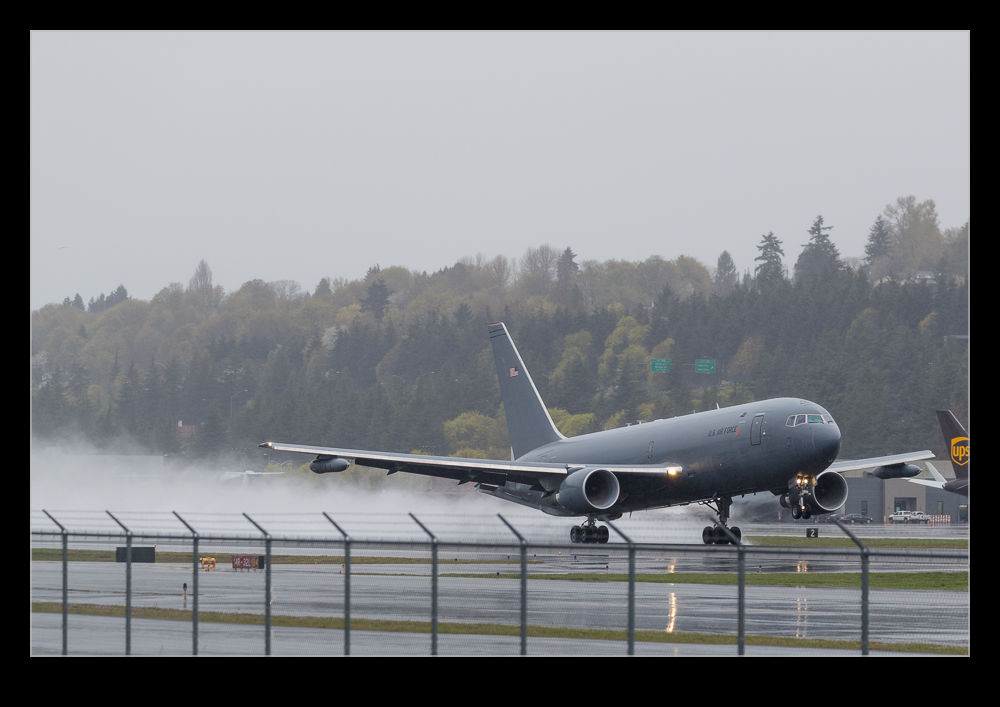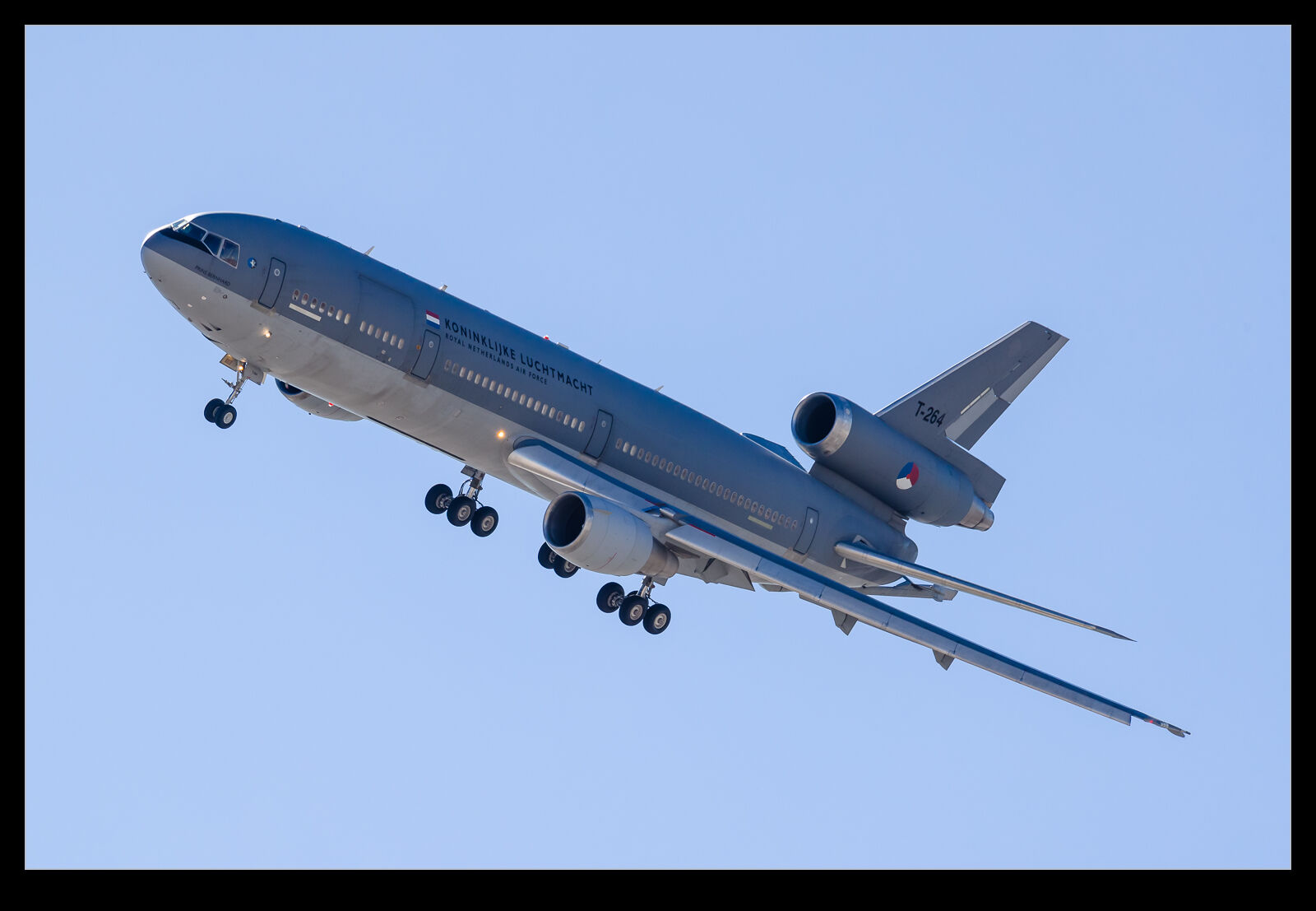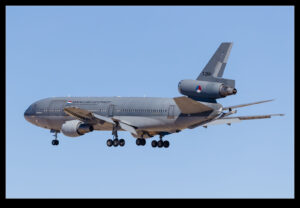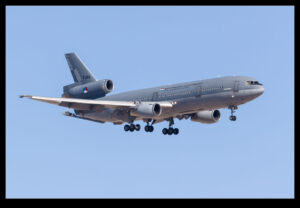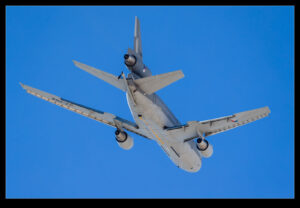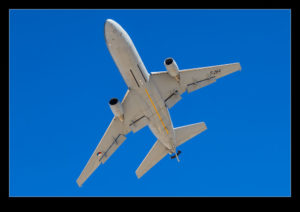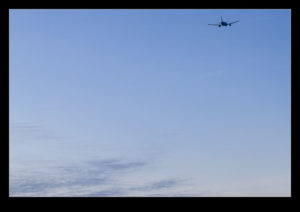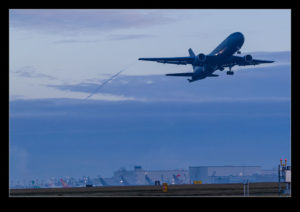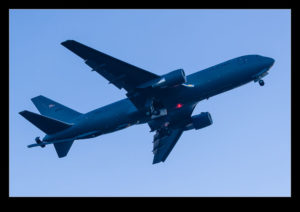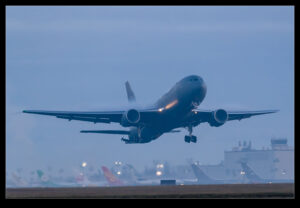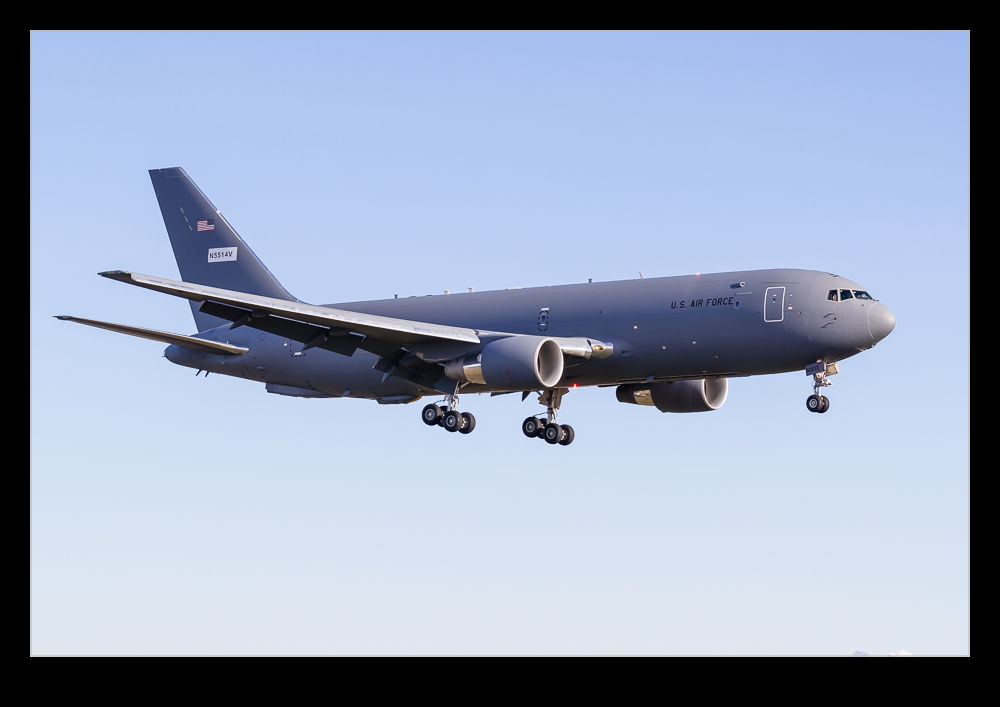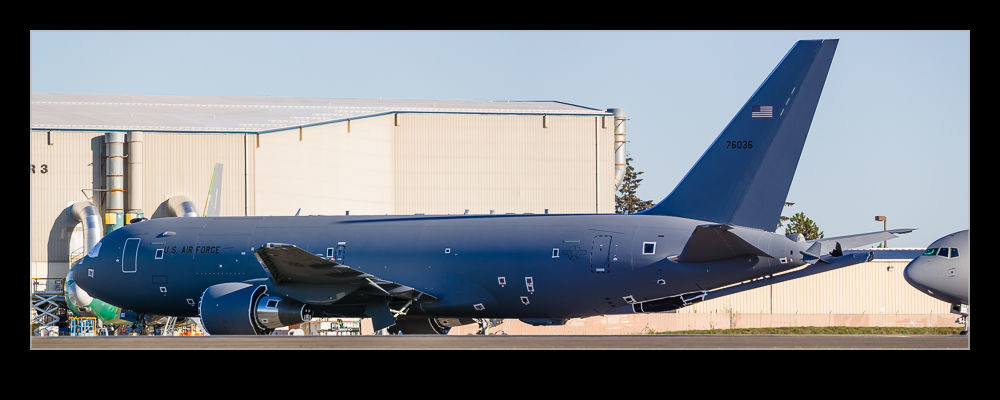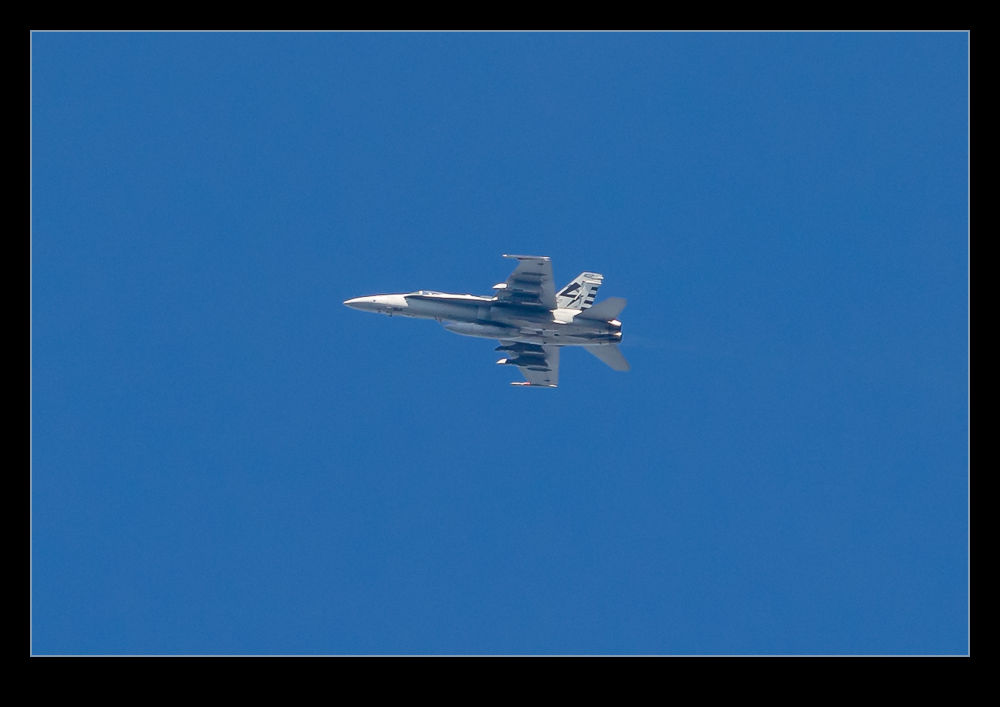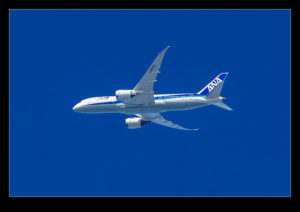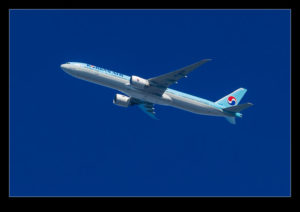 Boeing started delivering KC-46s to the USAF as I covered in this post. However, it didn’t take too long before the Air Force found various items of tooling in the aircraft that shouldn’t have been there and stopped taking delivery. Consequently, rather than delivering the backlog, it has continued to build. Paine Field had well over a dozen aircraft in various locations when we were there including three over by the Heritage Flight Foundation’s hangars. Here three were illuminated nicely by the sun as it rose across the field so a pano seemed in order.
Boeing started delivering KC-46s to the USAF as I covered in this post. However, it didn’t take too long before the Air Force found various items of tooling in the aircraft that shouldn’t have been there and stopped taking delivery. Consequently, rather than delivering the backlog, it has continued to build. Paine Field had well over a dozen aircraft in various locations when we were there including three over by the Heritage Flight Foundation’s hangars. Here three were illuminated nicely by the sun as it rose across the field so a pano seemed in order.
Tag Archives: tanker
Rainy Pegasus Takeoff
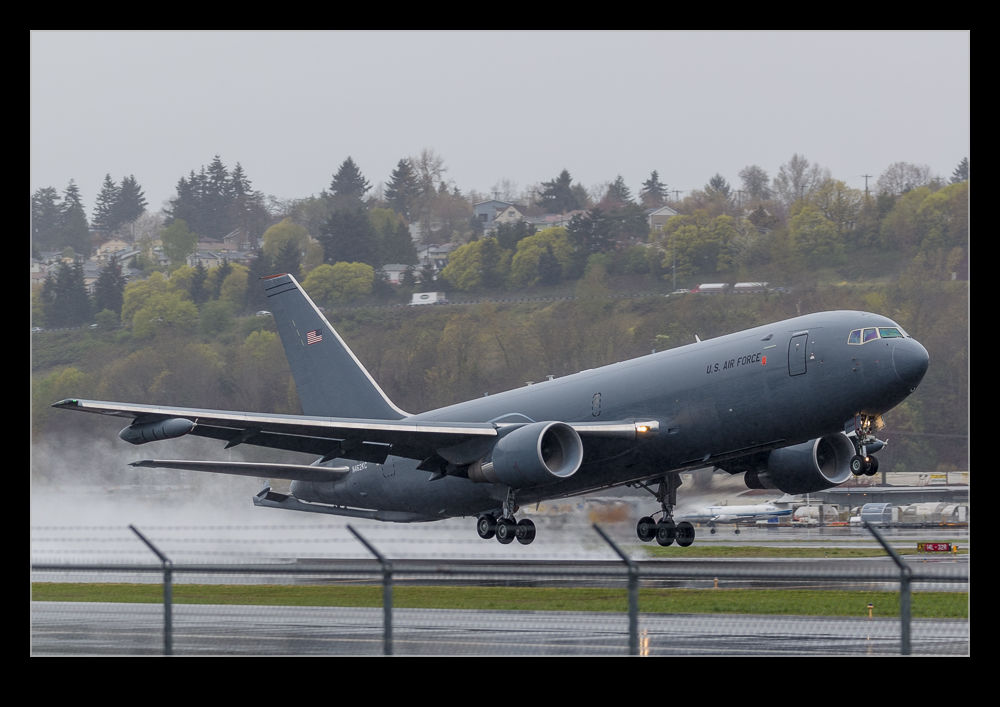 I have shot KC-46s in bad conditions more often than would seem probable. I got one in conditions so dark it was like a night shoot. This time it was heavy rain. Of course that can mean vapor. The matte gray of fuselage actually looks better when it is wet. I had hoped the inlets would fog but that didn’t happen. However, the flat light helped the fuselage a bit which often gets too contrasts. Besides that it throws up a ton of spray behind it as it accelerates down the runway. Rotating in front of me meant I was rather happy with the result compared to what I expected.
I have shot KC-46s in bad conditions more often than would seem probable. I got one in conditions so dark it was like a night shoot. This time it was heavy rain. Of course that can mean vapor. The matte gray of fuselage actually looks better when it is wet. I had hoped the inlets would fog but that didn’t happen. However, the flat light helped the fuselage a bit which often gets too contrasts. Besides that it throws up a ton of spray behind it as it accelerates down the runway. Rotating in front of me meant I was rather happy with the result compared to what I expected.
Dutch KDC-10
 There were two tankers I was hoping to shoot at Red Flag. One was the Colombian 767. It didn’t fly on the first day but on the second it started to taxi before returning to the ramp and shutting down. Never mind. The other was the Dutch KDC-10. I hadn’t shot one before and they are not likely to be in service for too much longer so this might have been my last chance. Therefore, I hoped it would fly and it didn’t let me down.
There were two tankers I was hoping to shoot at Red Flag. One was the Colombian 767. It didn’t fly on the first day but on the second it started to taxi before returning to the ramp and shutting down. Never mind. The other was the Dutch KDC-10. I hadn’t shot one before and they are not likely to be in service for too much longer so this might have been my last chance. Therefore, I hoped it would fly and it didn’t let me down.
 The winds were strong on the first day and it departed towards us off 21L. As soon as it was airborne, the nose cocked into the strong crosswind and it turned towards us. A right turn overhead and it was on its way to the ranges. When it returned, they went for a very impressive curving approach. It looked great. However, it wasn’t great from a flying perspective and a go around followed. The second approach was more conventional and more successful.
The winds were strong on the first day and it departed towards us off 21L. As soon as it was airborne, the nose cocked into the strong crosswind and it turned towards us. A right turn overhead and it was on its way to the ranges. When it returned, they went for a very impressive curving approach. It looked great. However, it wasn’t great from a flying perspective and a go around followed. The second approach was more conventional and more successful.
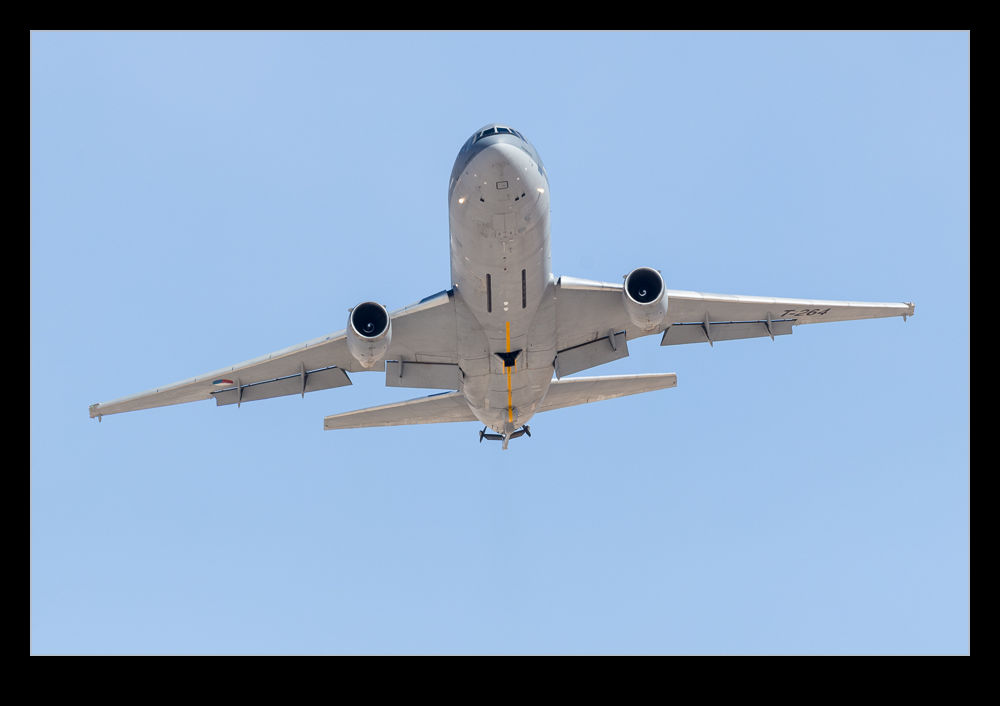 On the second day they flew again. This time the arrivals were from over the Speedway so a more traditional view of them coming in. I was hoping for a go around and a tight circuit to land but that was a tad optimistic. Maybe after the previous day they were more content to get the beast back on the ground.
On the second day they flew again. This time the arrivals were from over the Speedway so a more traditional view of them coming in. I was hoping for a go around and a tight circuit to land but that was a tad optimistic. Maybe after the previous day they were more content to get the beast back on the ground.
Juggling the Pegasuses
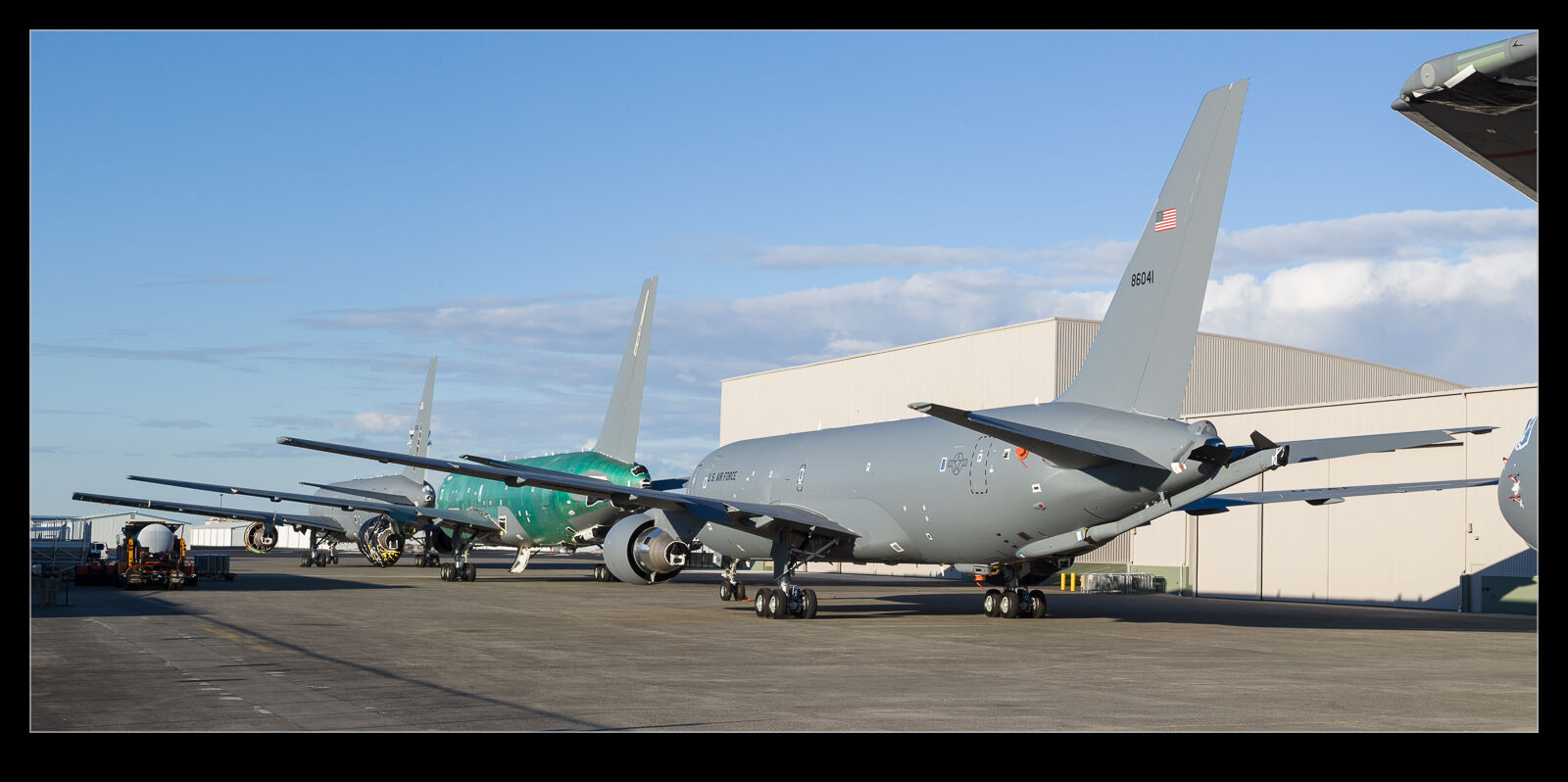 While the UPS freighter had enticed me to Everett, I was interested to see that Boeing was busy moving KC-46s around. They have a hangar at the south end of the field where they work on the Pegasus aircraft and they were taking on out of the hangar. To do this, they needed to move a bunch of them out of the way so they had a juggling act underway putting different planes in odd locations while they all were moved. They stuck a row of them down by the Flying Heritage and Combat Armor Museum.
While the UPS freighter had enticed me to Everett, I was interested to see that Boeing was busy moving KC-46s around. They have a hangar at the south end of the field where they work on the Pegasus aircraft and they were taking on out of the hangar. To do this, they needed to move a bunch of them out of the way so they had a juggling act underway putting different planes in odd locations while they all were moved. They stuck a row of them down by the Flying Heritage and Combat Armor Museum.
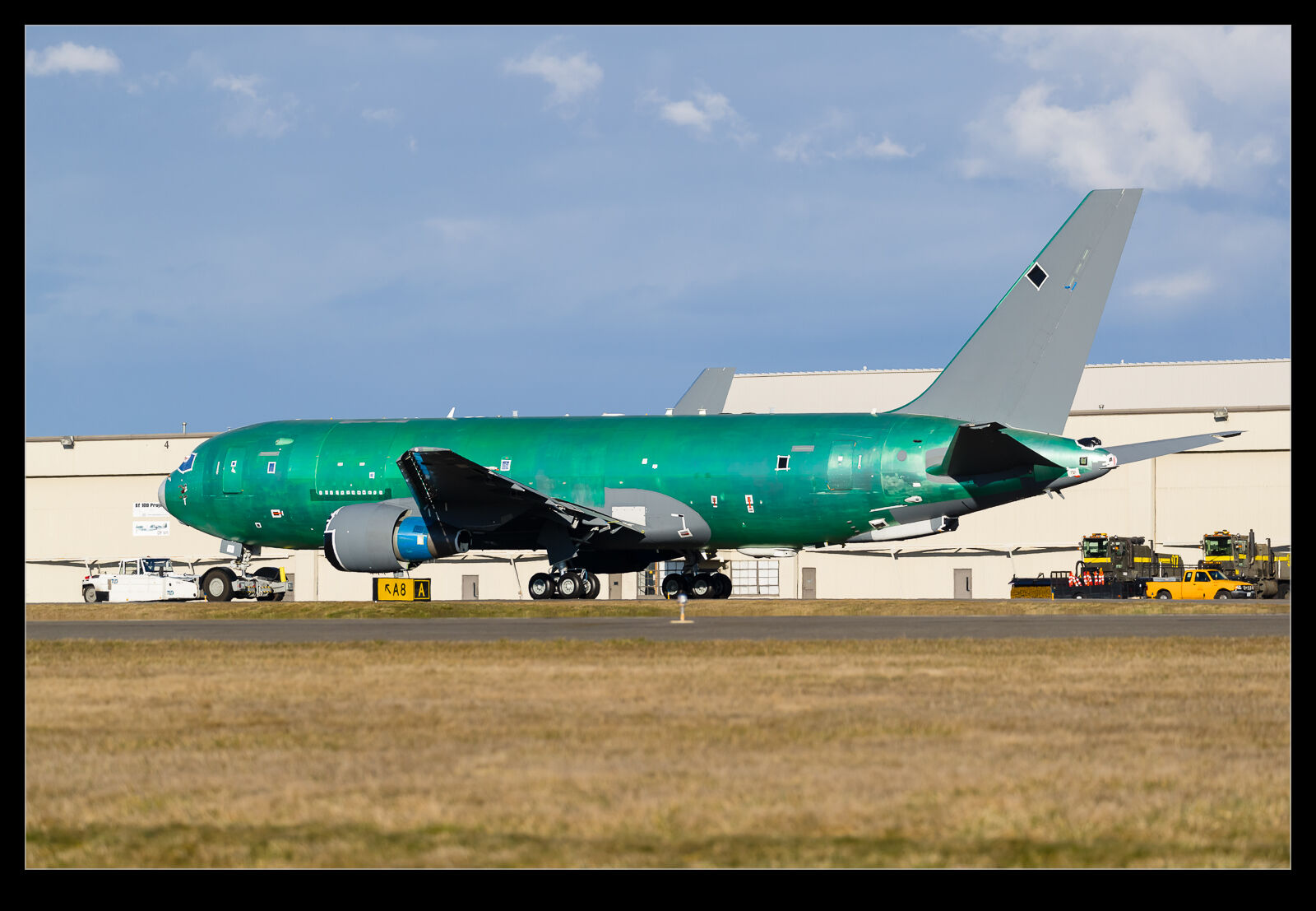 The plane came out of the hangar and was rolled off to park. Then, one that had been sitting outside for a while was moved back inside. I wasn’t going to hang around to see if they moved them all back that evening but I did go across to the museum side to see them parked in this odd location before leaving. At this time the Air Force had halted deliveries due to loose items in the received airframes so I guess the chance of more airframes stacking up was back on the cards.
The plane came out of the hangar and was rolled off to park. Then, one that had been sitting outside for a while was moved back inside. I wasn’t going to hang around to see if they moved them all back that evening but I did go across to the museum side to see them parked in this odd location before leaving. At this time the Air Force had halted deliveries due to loose items in the received airframes so I guess the chance of more airframes stacking up was back on the cards.
Medusa Flight for the First Delivery
 Finally, the first Boeing KC-46 Pegasus tankers were delivered to the USAF. Not one but two tankers were delivered in the ceremony, a nice effort at a joke by Boeing having left everyone thinking it would only be one. Then again, when you have that many of them sitting around, I guess it should have been even more! The ceremony took place on one day and the delivery was the following morning.
Finally, the first Boeing KC-46 Pegasus tankers were delivered to the USAF. Not one but two tankers were delivered in the ceremony, a nice effort at a joke by Boeing having left everyone thinking it would only be one. Then again, when you have that many of them sitting around, I guess it should have been even more! The ceremony took place on one day and the delivery was the following morning.
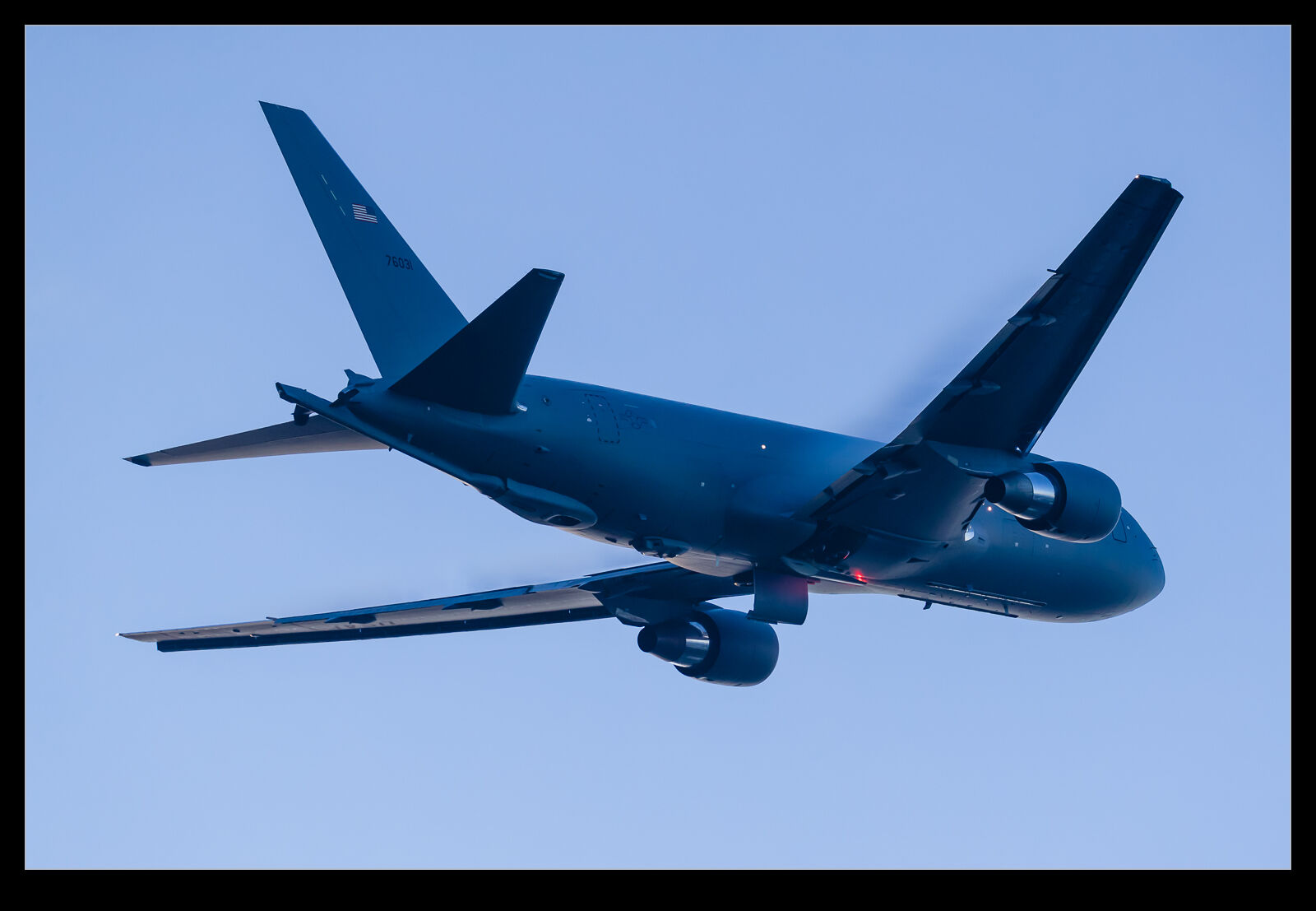 The jets left from Paine Field just after sunrise. That is sunrise if you don’t have clouds on the horizon. The sun had barely squeaked above those when the two jets took off as Medusa 1 and 2. They were preceded by a McConnell AFB KC-135R – the aircraft that they will be replacing. It got airborne in very limited light and headed for Kansas. Then the two new jets lined up in turn and departed. No flybys or wing waggles. Just gear up, switch to departure frequency and off into the steadily brightening sky. Avoid the traffic inbound to SeaTac and off you go. Lots more should be following soon while efforts continue to fix the issues with the camera system and the underwing hose and drogue pods.
The jets left from Paine Field just after sunrise. That is sunrise if you don’t have clouds on the horizon. The sun had barely squeaked above those when the two jets took off as Medusa 1 and 2. They were preceded by a McConnell AFB KC-135R – the aircraft that they will be replacing. It got airborne in very limited light and headed for Kansas. Then the two new jets lined up in turn and departed. No flybys or wing waggles. Just gear up, switch to departure frequency and off into the steadily brightening sky. Avoid the traffic inbound to SeaTac and off you go. Lots more should be following soon while efforts continue to fix the issues with the camera system and the underwing hose and drogue pods.

State of the Pegasus Fleet
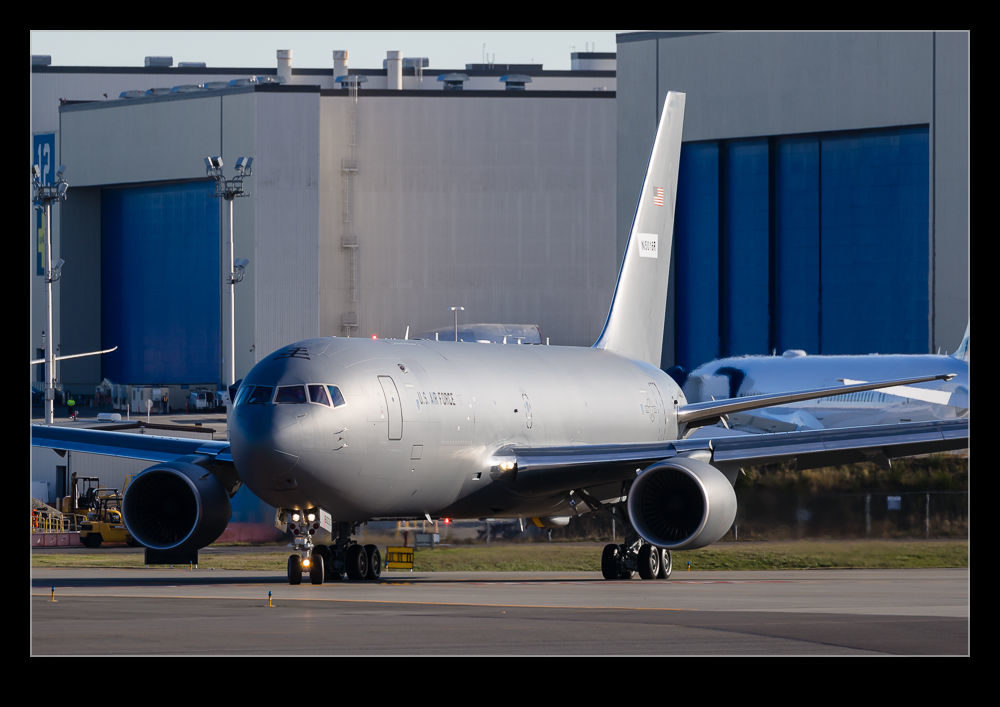
January 2019 brought a milestone for the USAF. They accepted their first KC-46 Pegasus. Admittedly they accepted it with a number of deferred issues that Boeing has been given a few years to resolve but that are Category 1 deficiencies. I guess this should mean we will see a lot of deliveries in the coming weeks and months.
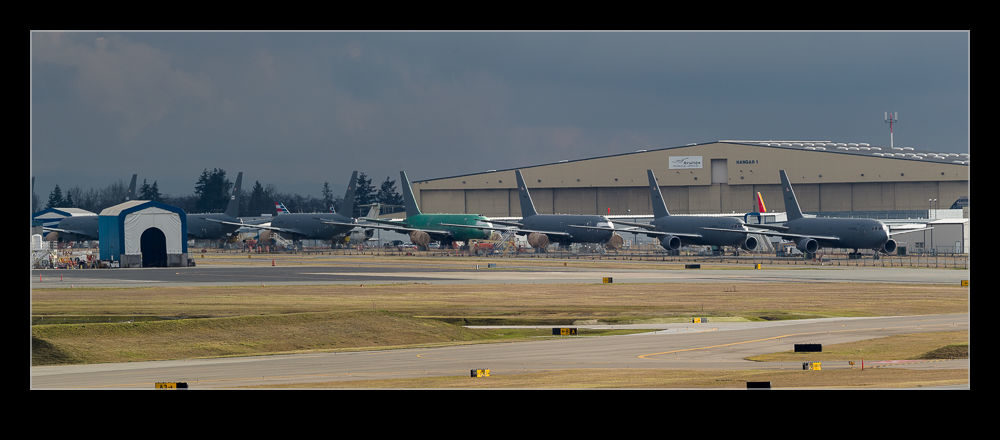
The backlog of jets parked up is substantial. There are jets parked at Boeing Field on both the military ramp and the flight test ramp. There are more scattered around the Boeing ramp at Everett. More of them are in the conversion area at the south end of Paine Field. More still are parked up across the cross runway. It’s a lot of jets and, if you are an accountant, this is a level of Work In Progress that must make you squirm. We should see them start to head on their way before too long.

West Seattle Bonuses
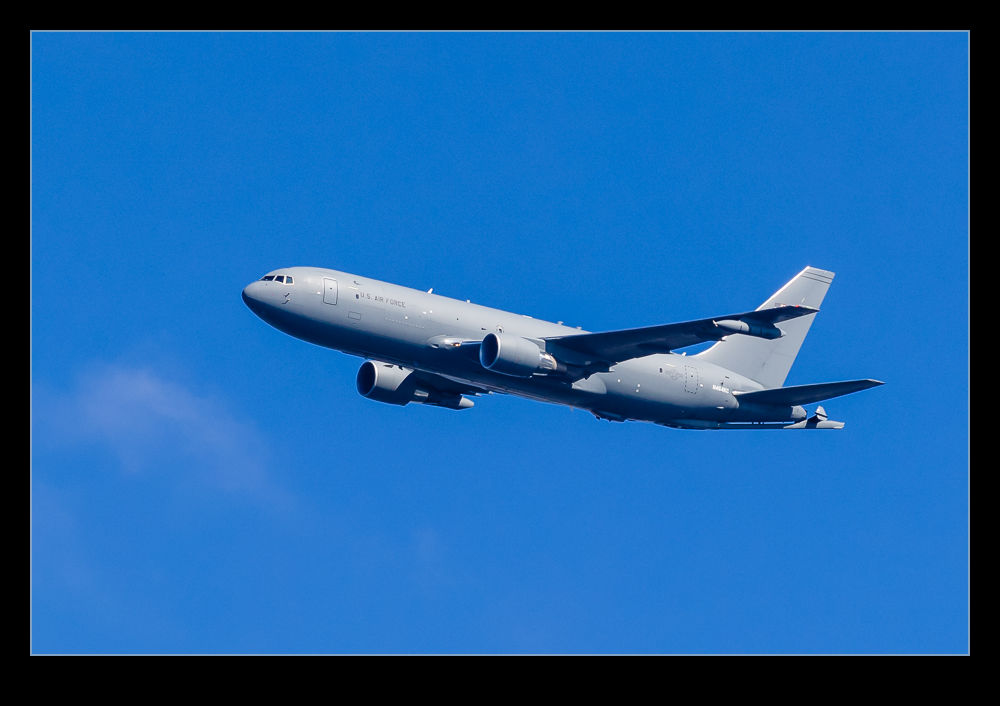 We made a trip to West Seattle with our guests while they were here. We were looking at the view of the city and also wondering what wildlife might show itself. I got a benefit in that departures from SeaTac and Boeing Field were coming to the north. I got a couple of nice airliner shots as they climbed out over us. They weren’t the only ones though. A KC-46 launched out of Boeing Field and climbed over us as it went off to its test area. I wasn’t paying attention, but my guests spotted something rocketing up behind it. An F/A-18C Hornet from the Strike Test unit was following it, presumably for some test work. It climbed rapidly but then leveled out, I assume to stay below the departure routes from SeaTac. Not a bad bonus for me while showing the sights to my guests.
We made a trip to West Seattle with our guests while they were here. We were looking at the view of the city and also wondering what wildlife might show itself. I got a benefit in that departures from SeaTac and Boeing Field were coming to the north. I got a couple of nice airliner shots as they climbed out over us. They weren’t the only ones though. A KC-46 launched out of Boeing Field and climbed over us as it went off to its test area. I wasn’t paying attention, but my guests spotted something rocketing up behind it. An F/A-18C Hornet from the Strike Test unit was following it, presumably for some test work. It climbed rapidly but then leveled out, I assume to stay below the departure routes from SeaTac. Not a bad bonus for me while showing the sights to my guests.
Details of a Pegasus
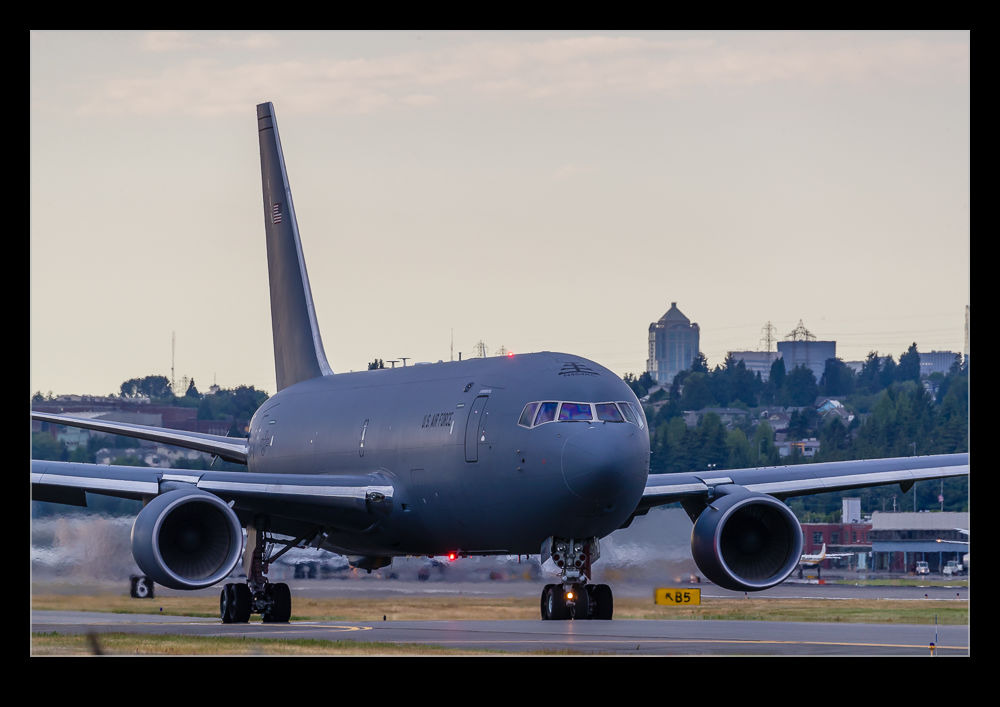 The KC-46 Pegasus test program drags on. The delivery of jets to the USAF is still not happening and the number of jets built increases but they are stacking up at Paine Field and Boeing Field. Meanwhile the test jets are working through test points and endeavoring to prove that the problems identified in previous tests are now resolved. I have seen a few jets now and shot them in varying conditions from sun to downpours.
The KC-46 Pegasus test program drags on. The delivery of jets to the USAF is still not happening and the number of jets built increases but they are stacking up at Paine Field and Boeing Field. Meanwhile the test jets are working through test points and endeavoring to prove that the problems identified in previous tests are now resolved. I have seen a few jets now and shot them in varying conditions from sun to downpours.
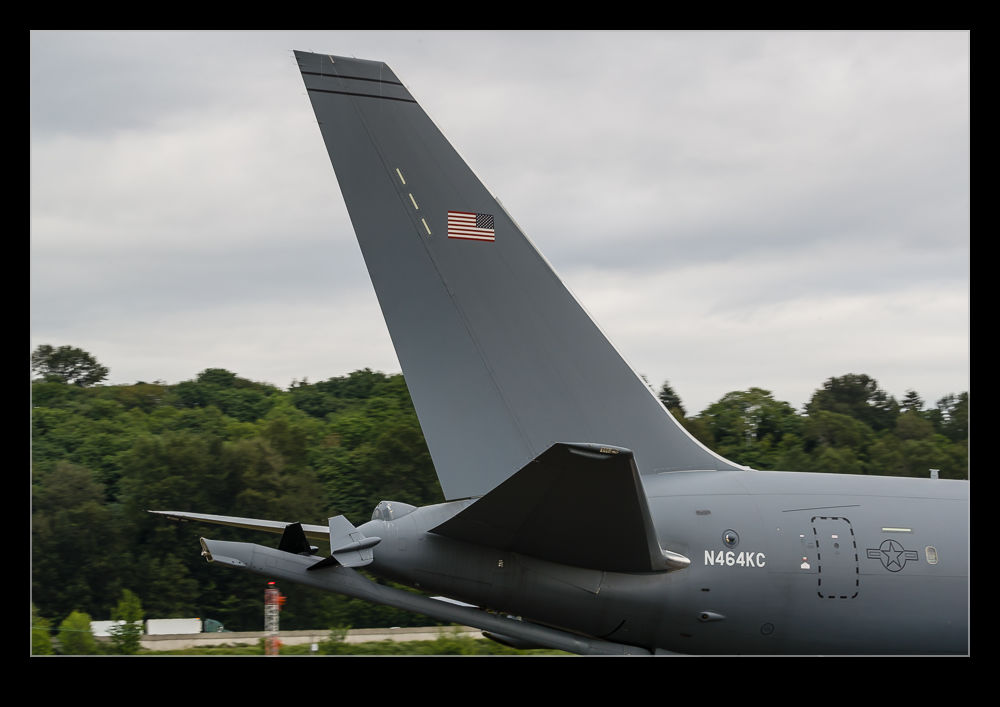 I was at Boeing Field one evening waiting to pick up someone at SeaTac later in the evening when one of the test jets taxied out from the Boeing ramp at the north of the field and came right by me prior to departing on another mission. The jet was configured with the boom and the underwing pods so the planned final configuration. As it came by, I decided to get some shots of the airframe to get a better idea of what the various parts look like.
I was at Boeing Field one evening waiting to pick up someone at SeaTac later in the evening when one of the test jets taxied out from the Boeing ramp at the north of the field and came right by me prior to departing on another mission. The jet was configured with the boom and the underwing pods so the planned final configuration. As it came by, I decided to get some shots of the airframe to get a better idea of what the various parts look like.
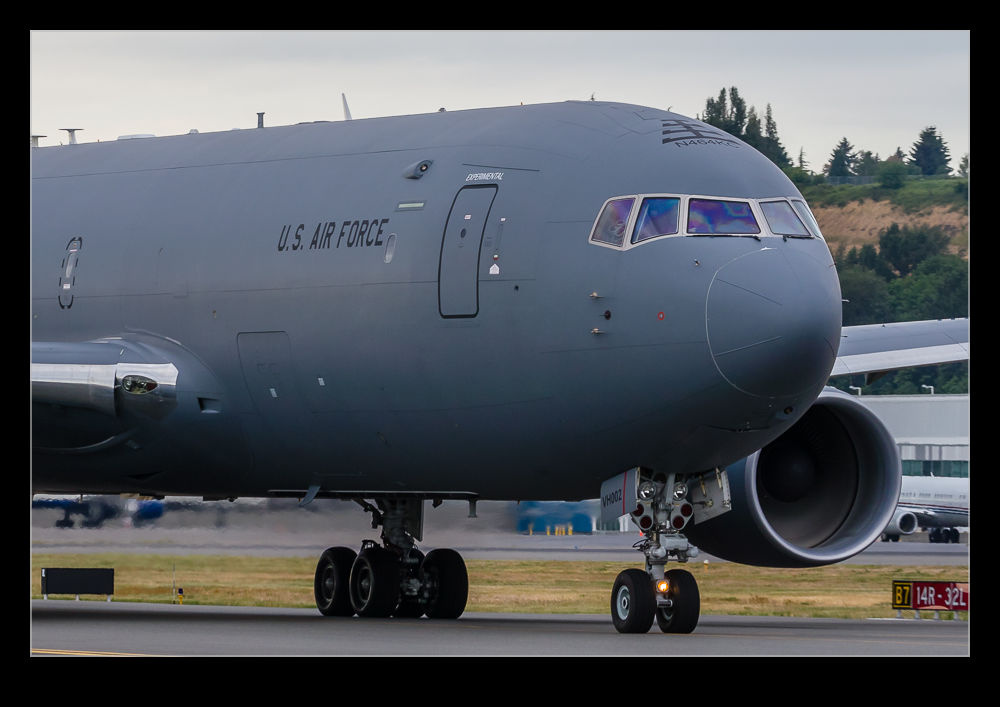 The airframe is the familiar 767 although there are some changes structurally. The cockpit is updated too but you can’t see that from the outside. However, you can see the various sensors mounted around the airframe which, I assume, are radar detectors. Above the cockpit is the receiver receptacle for the refueling boom to allow the jet to receive as well as dispense fuel. You can’t see much from the ground other than the markings to guide the boomer (and the markings that identify which jet it is).
The airframe is the familiar 767 although there are some changes structurally. The cockpit is updated too but you can’t see that from the outside. However, you can see the various sensors mounted around the airframe which, I assume, are radar detectors. Above the cockpit is the receiver receptacle for the refueling boom to allow the jet to receive as well as dispense fuel. You can’t see much from the ground other than the markings to guide the boomer (and the markings that identify which jet it is).
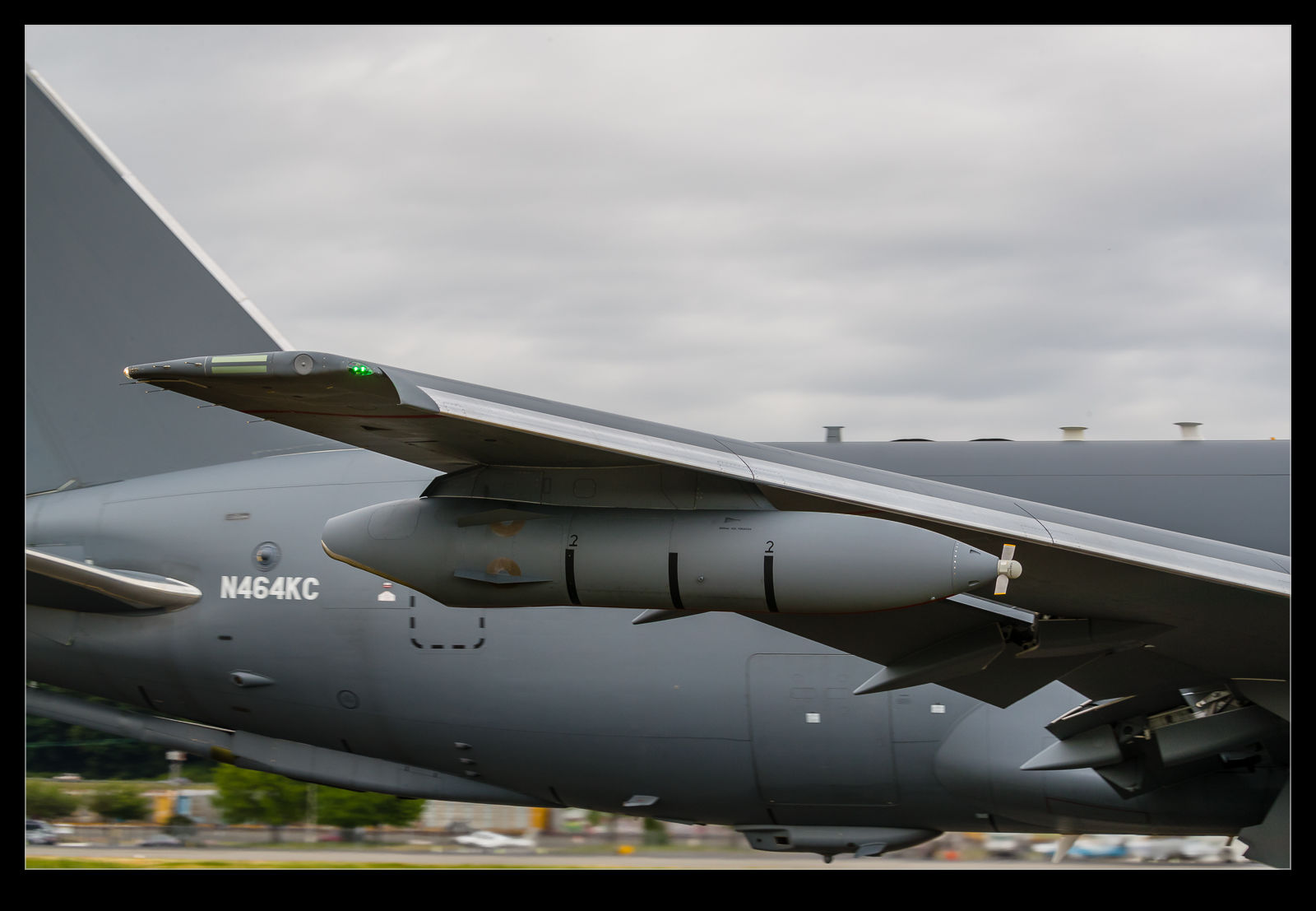 The underwing refueling pods are a source of some of the troubles the program is having. Apparently, the supplier in the UK underestimated what was required to achieve he civil certification that is part of the contract requirements. The pods may not be cleared when the initial jets finally enter service. Modern pods have a more streamlined look. Earlier pods have a blunt back end that the hose and drought come out of. The modern pods and more streamlined and the rogue comes out of a ramp in the bottom of the pod.
The underwing refueling pods are a source of some of the troubles the program is having. Apparently, the supplier in the UK underestimated what was required to achieve he civil certification that is part of the contract requirements. The pods may not be cleared when the initial jets finally enter service. Modern pods have a more streamlined look. Earlier pods have a blunt back end that the hose and drought come out of. The modern pods and more streamlined and the rogue comes out of a ramp in the bottom of the pod.
The back end has the boom. Given how many boom tankers Boeing has produced, modern booms seem to cause them a lot of trouble. This one is still one of the major defects with the jet. Hopefully it will be resolved soon. The boomer does not have a window like the earlier jets but instead uses stereo video cameras to give the boomer the view of what is going on. I assume some of the apertures around the rear fuselage are for the cameras to support this functionality. We shall see how long it is before we see this being used for real by the USAF as opposed to the test team.
Pegasus Testing with the Hornet (and it’s not raining)
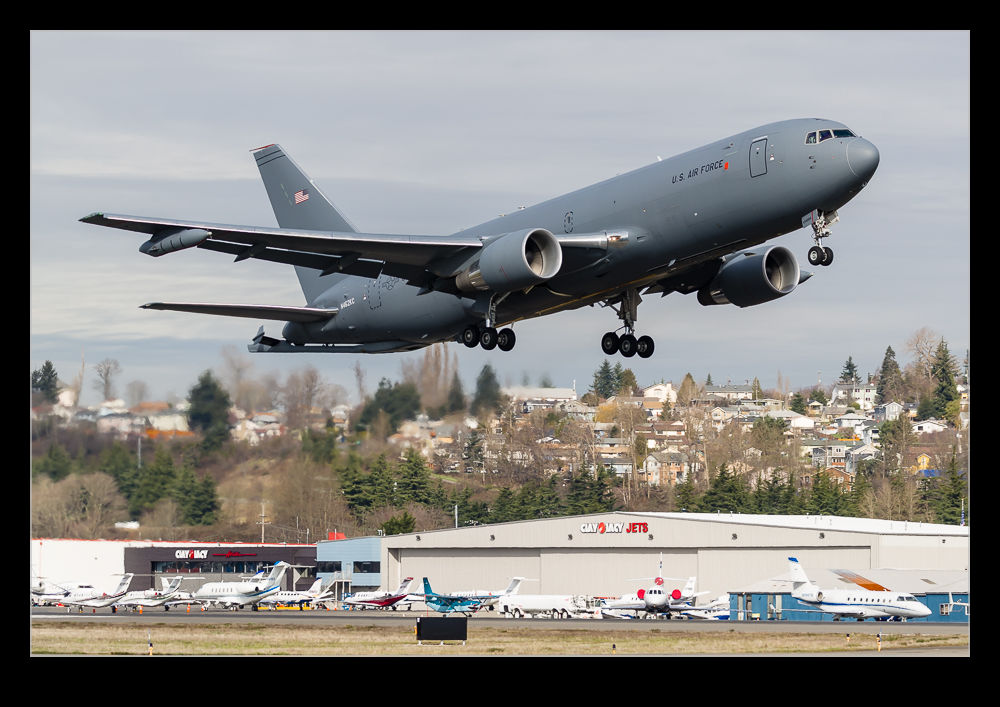 My luck with KC-46s and bad weather broke recently with a Pegasus launching out of Boeing Field on a glorious day. It was carrying out trials work with a US Navy Hornet. This jet was the subject of its own post. The KC-46 followed it down the runway. It rotated in a good location and the light was so much nicer than I have had recently so I was very happy to get shots of it as it climbed out and headed off to the airspace set aside for testing.
My luck with KC-46s and bad weather broke recently with a Pegasus launching out of Boeing Field on a glorious day. It was carrying out trials work with a US Navy Hornet. This jet was the subject of its own post. The KC-46 followed it down the runway. It rotated in a good location and the light was so much nicer than I have had recently so I was very happy to get shots of it as it climbed out and headed off to the airspace set aside for testing.
Sure, Wait for the Storm
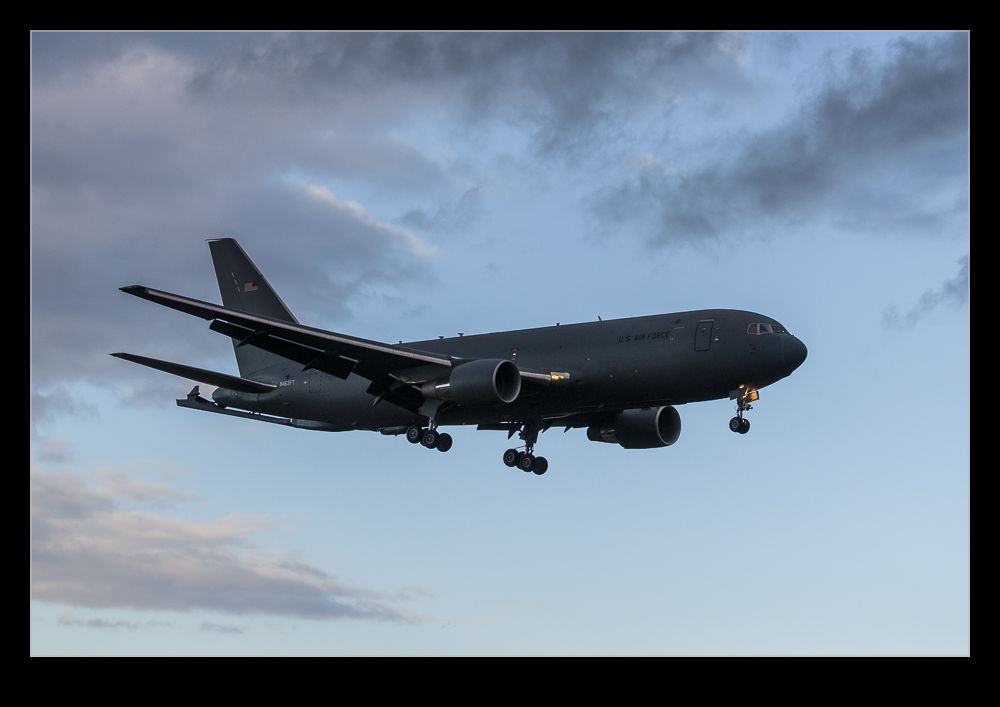 When the weather starts to turn, you can assume that whatever you are waiting for is likely to show up just after it gets bad. In this case, a KC-46 Pegasus was on its way back to Boeing Field and the clouds were rolling in. Things were getting darker and it looked like the clouds would open. Meanwhile, the KC-46 was still a distance away.
When the weather starts to turn, you can assume that whatever you are waiting for is likely to show up just after it gets bad. In this case, a KC-46 Pegasus was on its way back to Boeing Field and the clouds were rolling in. Things were getting darker and it looked like the clouds would open. Meanwhile, the KC-46 was still a distance away.
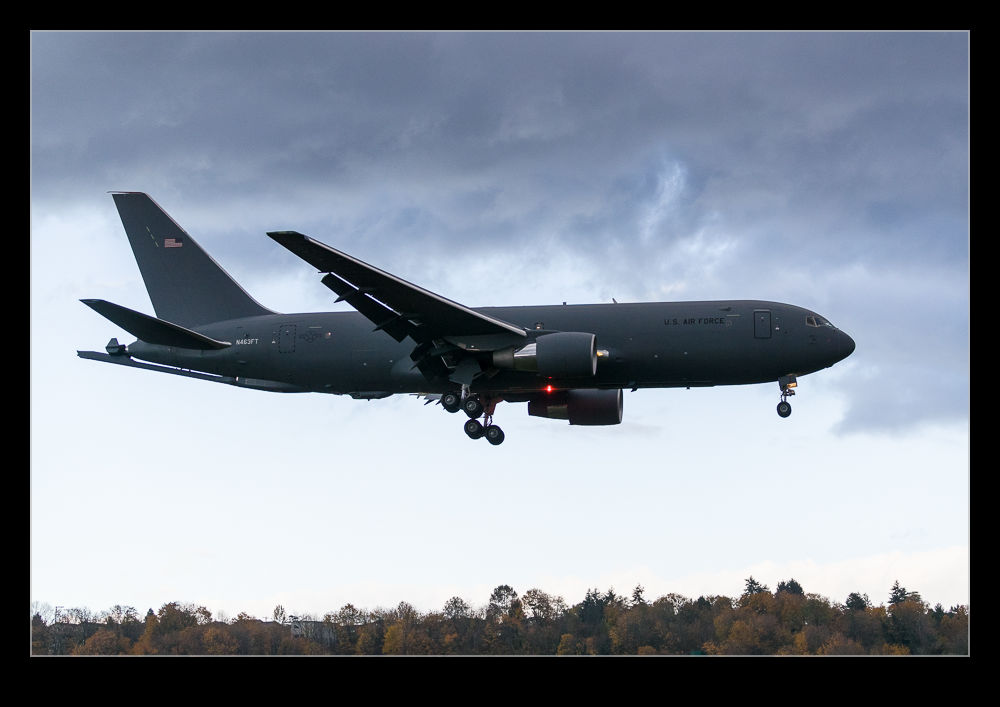 Sure enough, the skies opened. By the time the jet was on final approach, the light had disappeared and the rain was belting down. I got some shots of it but, even with a bunch of exposure compensation, the jet was more of a silhouette than anything else. A little post processing help brought out the detail but this was not an ideal shooting situation. A dark grey jet in dying light is just what you want!
Sure enough, the skies opened. By the time the jet was on final approach, the light had disappeared and the rain was belting down. I got some shots of it but, even with a bunch of exposure compensation, the jet was more of a silhouette than anything else. A little post processing help brought out the detail but this was not an ideal shooting situation. A dark grey jet in dying light is just what you want!

